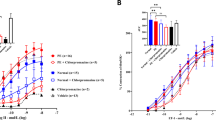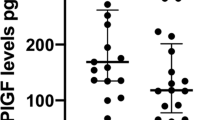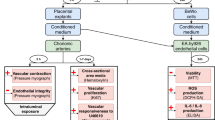Abstract
THE demonstration that certain arteries and veins have the ability to generate from prostaglandin (PG) endoperoxides an unstable substance called prostacyclin (PGl2) (ref. 1), which will inhibit platelet aggregation2,3, should lead to a reappraisal of the homeostatic mechanisms preventing thrombosis. It has been suggested that the endothelium of these blood vessels contains an enzyme which is capable of converting PG endoperoxides from circulating platelets into an unstable substance, prostacyclin. This inhibits platelet aggregation and so prevents the initial step of thrombus formation within the vessel4. Damage to the endothelium of the vessel wall may prevent production of the enzyme PGI2 synthetase, and the subsequent reduction in the local synthesis of prostacyclin could facilitate platelet aggregation in the area of damage. Maintenance of an adequate circulation within the placenta is critical to foetal well-being. This circulation is one both of low pressure and velocity and the presence of a substance which has a potent inhibitory effect on platelet aggregation would seem desirable for its maintenance. We demonstrate here the ability of normal placental tissue to generate a labile substance which has the ability to inhibit ADP-induced platelet aggregation. The properties exhibited by this substance are suggestive of it being PGI2.
This is a preview of subscription content, access via your institution
Access options
Subscribe to this journal
Receive 51 print issues and online access
$199.00 per year
only $3.90 per issue
Buy this article
- Purchase on Springer Link
- Instant access to full article PDF
Prices may be subject to local taxes which are calculated during checkout
Similar content being viewed by others
References
Johnson, R. A. et al. Prostaglandins 12, 915–928 (1976).
Moncada, S., Gryglewski, R. J., Bunting, S. & Vane, J. R. Nature 263, 663–665 (1976).
Moncada, S., Higgs, E. A. & Vane, J. R. Lancet i, 18–21 (1977).
Gryglewski, R. J., Bunting, S., Moncada, S., Flower, R. J. & Vane, J. R. Prostaglandins 12, 685–713 (1976).
Myatt, L. & Elder, M. G. Br. J. Obstet. Gynaec. 82, 449–452 (1975).
Moncada, S., Gryglewski, R. J., Bunting, S. & Vane, J. R. Prostaglandins 12, 715–737 (1976).
Ho, P. P. K., Herrmann, R. G., Towner, R. D. & Walters, C. P. Biochem. biophys. Res. Comm. 74, 514–519 (1977).
Needleman, P. et al. Nature 261, 550–560 (1976).
Vane, J. R. Nature new Biol. 231, 232–235 (1971).
Howie, P. W., Prentice, C. R. M. & McNicol, G. P. J. Obstet. Gynaec. Br. Commonw. 78, 992–1003 (1971).
Author information
Authors and Affiliations
Rights and permissions
About this article
Cite this article
MYATT, L., ELDER, M. Inhibition of platelet aggregation by a placental substance with prostacyclin-like activity. Nature 268, 159–160 (1977). https://doi.org/10.1038/268159a0
Received:
Accepted:
Issue Date:
DOI: https://doi.org/10.1038/268159a0
This article is cited by
-
Vasodilator factors in the systemic and local adaptations to pregnancy
Reproductive Biology and Endocrinology (2009)
-
Prostaglandin metabolism in umbilical vessels of smoking and non-smoking mothers
Archives of Gynecology (1987)
-
Does prostacyclin mediate alpha-adrenergic induced hypotension?
Documenta Ophthalmologica (1982)
-
Behaviour of IOP and pupil size after topical tranylcypromine in the rabbit eye
Documenta Ophthalmologica (1981)
-
Blood platelets do not provide endoperoxides for vascular prostacyclin production
Nature (1979)
Comments
By submitting a comment you agree to abide by our Terms and Community Guidelines. If you find something abusive or that does not comply with our terms or guidelines please flag it as inappropriate.



